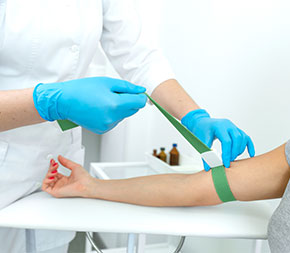In this Article

There are no nationally required phlebotomy professional certifications. In fact, unless you live in California, Nevada, Washington, or Louisiana, you don’t need any kind of certification or license to work as a phlebotomist. However, that doesn’t mean certification isn’t important for your phlebotomy career after you’ve completed your education.
Certification is a great way to prove you’ve mastered the basics of phlebotomy and that you have the skill and knowledge you need to perform your job safely, efficiently, and accurately. Plus, many employers do require or strongly prefer certification. It shows you’ll be ready to take on the more advanced or specialized tasks that specific workplaces require. That makes certification a smart move, no matter what state you live in.
“Every institution has different requirements for phlebotomists, but many institutions require a basic certification,” says D’Vaughn House, a phlebotomist, medical assistant, and research associate at the University of Cincinnati Medical Center’s Division of Infectious Diseases. He explains that trained phlebotomists who’ve earned certifications are ready to adapt to any medical facility. Once they’re hired by an institution, they’re ready to be trained per the clinic’s protocols.
Certificate vs Certification
- Certificate
- A certificate is awarded by an educational institution, and signifies that a student has satisfactorily completed a given curriculum. Certificate programs can help students prepare for certification exams.
- Certification
- A certification is generally awarded by a trade group after an individual has met certain professional requirements (e.g. earned a specific degree, worked professionally in a given field for a set amount of time, etc.) and passed a certification exam.
In short, a certificate is evidence that someone has completed an educational program, while a certification denotes that someone has met a certain set of professional criteria and/or passed an exam.
Not all programs offered are designed to meet state educator licensing or advancement requirements; however, it may assist candidates in gaining these approvals in their state of residence depending on those requirements. Contact the state board of education in the applicable state(s) for requirements.
Before you earn professional certification, you must complete a phlebotomy training program. Phlebotomist school is short in length—one to two semesters, or 4 to 8 months, depending on your school. You’ll be awarded a certificate, which is different than certification, which prepares you to work with patients in different settings such as labs, blood banks, and hospitals.
Available Certifications
There are three primary certifications for phlebotomists. These certifications carry national recognition. They’re a good bet for phlebotomists who want to add a certification to their resumes.
It’s important to note that all three primary certifications may allow you to practice phlebotomy at the same level and same workplaces. The primary differences are the exam costs, paths to eligibility, and renewal requirements.
Phlebotomy Technician (PBT)
The PBT certification is offered by the American Society for Clinical Pathology (ASCP). The ASCP has been around for nearly 100 years. It offers several extremely well-known and well-respected certifications for phlebotomists and lab technicians. The society’s PBT certification has long been sought by employers.
Eligibility: You’ll be eligible for the PBT if you’re a high school graduate or GED-holder who attended a phlebotomy program approved by the National Accrediting Agency for Clinical Laboratory Sciences (NAACLS) or approved by the California Department of Public Health in the past five years. You can also become eligible by completing a formal phlebotomy training program that has been approved individually by the ASCP or by gaining a year of full-time phlebotomy work experience at an approved lab. RNs, LPNs, and other licensed healthcare professionals are also eligible.
Exam: The certification exam has 80 computer-based questions.
Cost: $135
Renewal: You’ll need nine continuing education credits every three years for renewal.
Certified Phlebotomy Technician (CPT)
The CPT is offered by the National Healthcareer Association (NHA), one of the most recognizable names in allied health certifications. The NHA also certifies pharmacy technicians, patient care technicians, medical assistants, and more. Similar to PBT certification, CPT certification is both recognized and sought by employers. It’s a definite plus to add to your resume.
Eligibility: You’ll need a high school diploma or GED and to have completed a formal phlebotomy training program within the last five years. You can also become eligible with a high school diploma or GED and one year of supervised phlebotomy work experience within the last three years.
Exam: The exam has 100 computer-based questions.
Cost: $117
Renewal: You’ll need to complete 10 continuing education hours every two years for renewal.
Registered Phlebotomy Technician (RPT)
RPT certification is available from the American Medical Technologists (AMT). A widely recognized allied health certification agency, AMT is a non-profit that has been around since 1939. They offer respected certifications in a variety of allied health professions. As a result, RPT certification is well known to—and often required by—employers.
Eligibility: You’re eligible for RPT certification if you attended an approved phlebotomy program consisting of at least 120 instructional hours in the past four years. You’re also eligible if you worked at least 1,040 hours as a phlebotomist in the past three years. No matter which route you take, you’ll also need a high school diploma and proof of at least 50 successful venipuncture and 10 successful capillary punctures.
Exam: The exam has 200 computer-based questions.
Cost: $125
Renewal: You can renew annually for a fee or every three years at no cost if you take 24 continuing education credits.
Additional Certifications
There are additional certification options available. There is no harm in earning any of these certifications. However, they aren’t as widely recognized as the PBT, CPT, or RPT.
Which Certification Is Right for Me?
There are several factors to consider when you’re trying to determine the right certification for your phlebotomy career. There’s no single right answer or best certification. However, there are some questions to consider that can help you make the best choice:
About the Exams
You’ll need to take a competency exam no matter which certification route you choose. The exam will test the knowledge you learned in your phlebotomy education program. You should expect to answer questions about:
You’ll also be asked a variety of scenario-based questions. These will ask you to choose the best response to hypothetical patient interactions or workplace situations. For example, they might ask what you would do in the case of a patient who fainted while you were drawing their blood, or how you would communicate with a non-verbal patient.
There are study guides and practice tests available online for all certification exams. Additionally, your phlebotomy education program will likely have study groups or classes available. If it’s been a while since you attended a program, or if you’re eligible based on experience and not education, online study guides can be a major help.
Are Phlebotomists Required to be Certified or Licensed?
There are only four states that require phlebotomists to be certified or licensed. You’ll need certification or licensure if you want to work as a phlebotomist in California, Washington, Louisiana, or Nevada. The exact certification rules depend on which of these states you live in.
California
California certifies three levels of phlebotomists:
Washington
You’ll need to submit a certification application to the Washington State Department of Health that includes proof of your phlebotomy education from an approved program and proof of at least seven hours of AIDS training along with criminal and professional background checks. You’ll need to renew your certification every two years.
Louisiana
Louisiana requires that all licensure applicants complete an approved phlebotomy training program. You’ll also need to earn a certification. Louisiana accepts any of the certifications mentioned in this article. You’ll need to submit proof of your education and certification along with valid CPR certification and criminal background check to the Louisiana State Board of Medical Examiners.
Nevada
In Nevada, phlebotomists need a lab assistant license. You’ll need to earn certification from any of the agencies mentioned above to qualify.
Salary and Job Growth
Phlebotomists may enjoy a salary that is comparable to many other allied health professionals, including medical assistants and pharmacy technicians. Earning certification is one way you may be able to boost your earning potential. Plus, certification is a great way to show your dedication in a field that’s expected to grow.
Roles for phlebotomists are expected to be added at medical facilities all over the country throughout the next decade. In fact, more than 13,900 new phlebotomy roles are expected to be created by 2031, according to the U.S. Bureau of Labor Statistics. It’s not certain that every single one of those 13,900 roles will require certification, but it’s possible many of them will.

Written and reported by:
Stephanie Srakocic
Contributing Writer

With professional insight from:
D’Vaughn House
Phlebotomist, University of Cincinnati Medical Center, Division of Infectious Diseases